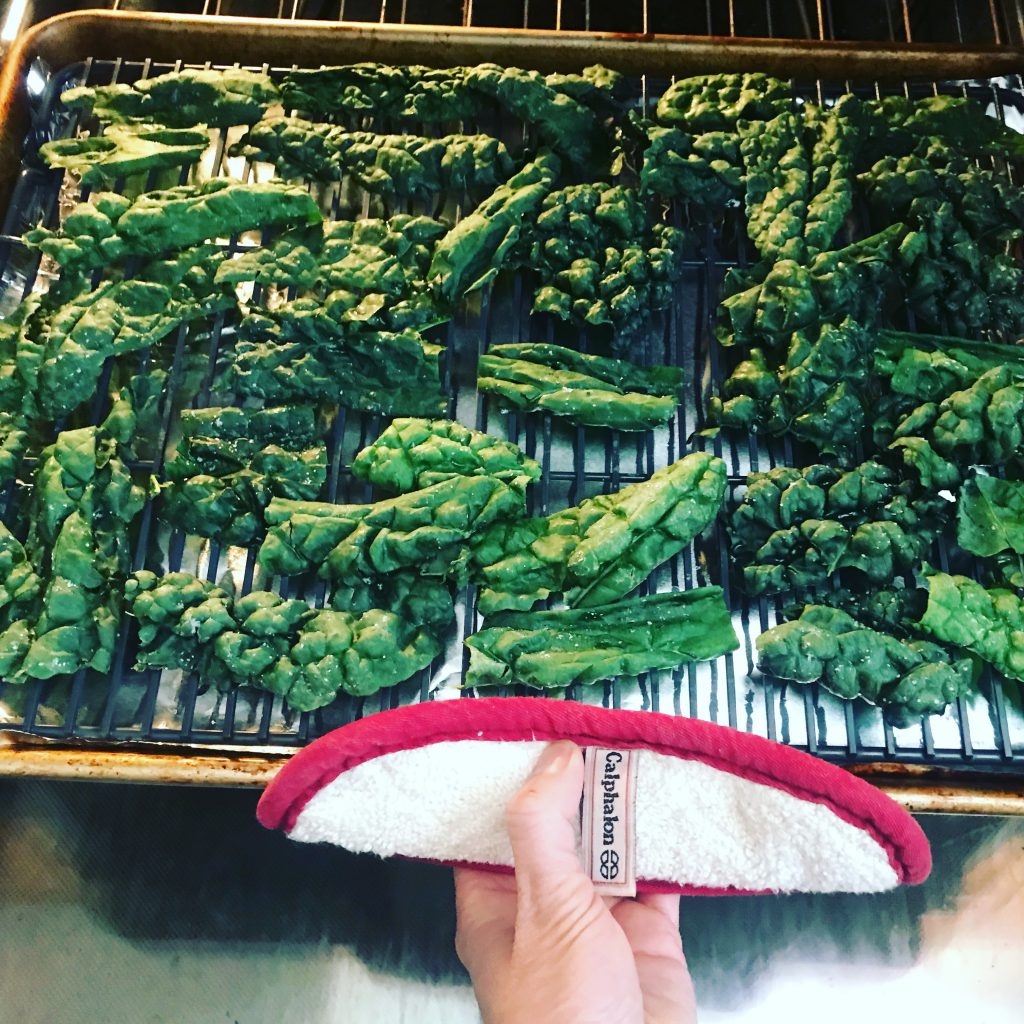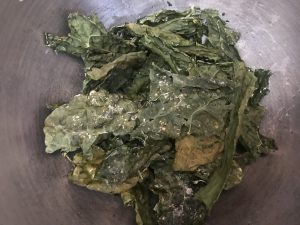
Learn how to make a delicious snack for adults and kids alike out of kale. It’ll make a kale fan out of you. All photos provided by Imei Hsu.
I admit it — I’m crazy about kale. Yet my current adoration didn’t start that way. I didn’t start liking kale until fairly recently, and even that liking developed somewhat by chance.
Not a fan of kale? I understand, really I do! Kale has an earthy, herbaceous, and bitter taste. When cooked and served undressed, it can taste like you are eating a handful of chewy dirt. I get it.
An inspiring triathlete and #Zipperclub member (heart attack and stroke survivor) Kyle Watson (@mrcrampy on Instagram) and I were chatting by text the other day, and after I asked him about foods he didn’t particularly like, Kyle shared that he has never liked kale or collards. “Too bitter,” he texted. He declared kale to be, “Yucky kale”! But Kyle also shared that one of his non-negotiable food choices post race is Top Ramen or Cup O’ Noodles, because he needs the salty broth to help him recover. Suddenly the wheels were turning.
Before you or your kids run away when kale is on the table, let me share just a few thoughts about kale that might help you think about giving it another whirl. And since I’m all about making food fun again, I promise that this way of preparing kale might make you a kale fan. Kyle, that means you too!
Accidentally Falling In Love by Necessity
When I started traveling more and needing a way to bring my food with me wherever I went, I came up with an idea. Hotels, restaurants, planes, trains, and automobiles with a cup holder all had one thing in common: you have access to hot water with little to no risk of cross contamination when it comes time to feed yourself. If I prepared dehydrated food ahead of time, placed it in a thermos, and added hot water, I had a meal that was more nutritious than Top Ramen, and obviously more safe for me to eat. It could also deliver the sodium I needed.
I assembled my experimental “travel” meal in a thermos. Rice stick noodle, cooks in five minutes when exposed to hot water, check. Dehydrated bacon or gluten free beef jerky, softens in hot water in five minutes, check. Salt and pepper, easy to find or add to the thermos before leaving my house, check. But what about a vegetable?
Well, Cup O’ Noodles, designed by Taiwanese-born Momofuko Ando, who saw people lining up around a block for a tiny bowl of ramen noodles in post-World War II Japan, was my model. The typical cup has dehydrated wheat noodles, dehydrated meat flavor for the broth, salt and other spices, and dehydrated peas and carrots. The whole thing is a trip to the hospital for the average Celiac, but for the starving college student without Celiac Disease, it is a satisfyingly cheap meal.
My challenge was that peas are a no-go for me. Though a great source of protein, peas make my tummy hurt, as they are a part of the legume family that causes my gut distress in the form of cramping and diarrhea, followed by days of mild joint inflammation. What I needed was a nutritious substitute for peas and carrots, and preferably one that held up nicely in a bowl of rice noodles and hot water. That ain’t going to happen if you throw some iceberg lettuce from a mid-flight salad. Yuck.
Ah, the mighty kale fits the bill nicely. Its bumpy, robust texture and fibrous composition can take a dousing in hot water, and it is full of nutritious vitamins, phytonutrients, fiber, and even a small amount of protein. The only problem is that five minutes in hot water wouldn’t soften fresh kale in each of my kitchen tests, and fresh kale in a thermos, sitting for longer than 24 hours, could become limp and pungent even if kept dry.

Use a dehydrator or your oven to make kale chips for your travel food.
Being a problem solver, I started looking into using a dehydrator to turn pieces of kale into crispy chips, which can be eaten alone, or added to the dehydrated foods in a thermos and rehydrate as quickly as the rest of the items. After testing this combination of rice stick noodle, jerky or dehydrated bacon, and dried and salted kale, I had my own cup of Celiac-safe noodles. Calorie for calorie and ingredient for ingredient, it is superior to anything you could get commercially, and safe to eat. You can even set it aside in plastic baggies, and they would stay good for at least three months without refrigeration as long as the baggies were air tight. Probably longer, but three months is a very safe and conservative bet with my observations during home kitchen testing.
Necessity is the mother of invention. And though I didn’t invent kale chips, I stumbled across this happy accident, and realized something else. When you dehydrate kale and add salt, it tastes like a crunchy potato chip, just without the problems associated with eating nightshades.
Brine it or Salt It? Your choice
Brining and salting food has been a means of preserving, softening, and preparing bitter foods for centuries. It’s your choice whether you want to soak your strips of kale in water with salt for one hour prior to dehydration, or if you want to salt pieces of kale generously and dehydrate it.
The bitter flavor associated with kale is completely banished through the salting and dehydrating process. It ends up tasting a bit more like salty broccoli, in my opinion. So if you like, or at least tolerate, broccoli more than kale or collards, get ready for a reintroduction of kale that is surprisingly tasty.
Creating a salty vegetable that eats like a chip has another ingenious purpose. On the day before a long-volume bike ride, run, hike, or hot day in the sun, I have to load up on sodium and fluids. Our bodies need sodium to help hold fluid in our blood cells. Without enough sodium, fluid moves into the interstitial compartments of our bodies, or fluid is simply dumped off in your urine. What you end up with is dehydration, or a syndrome that mimics dehydration; what it can be is extracellular fluid build up, which can look like edema in the legs, hypotension, and reduced cardiac output. Active people will often take electrolyte tablets or drink special sport drinks that contain a concentration of sodium and potassium to counteract the amount of fluid and sodium loss during exercise, and for most people, that’s enough to ward off dehydration as long as they are taking in enough fluids.
But I have a curious combination of challenges when it comes to salt intake. Not only is my food mostly sodium free naturally — it’s not processed or packaged, and therefore there isn’t enough salt unless I add it — but I have a kidney that can’t process fluids fast enough without causing problems, so I cannot pre-hydrate the way some people can. It’s the reason why I can’t take a hot yoga class — I can’t drink two liters of water beforehand! So, as much as people think I eat bacon because it tastes good, I also eat bacon because it delivers a wallop of sodium, which is just what I need to help get me through all my adventures safely.
 Dehydrated kale with extra salt, then, is a great pre-workout sodium loading food as well as a post workout recovery snack. I can tuck a plastic container of it in my bag for eating after a training workout or a race, and it really helps with my salt replacement. But watch out! There is a butt load of sodium on those chips, so remember, a little goes a long way. You don’t need to eat an entire serving (one cup of cooked kale); 7-10 chips will be quite enough. I warn you, because they taste so good, you might find yourself wanting to go for a second helping! I kid you not, they taste really good.
Dehydrated kale with extra salt, then, is a great pre-workout sodium loading food as well as a post workout recovery snack. I can tuck a plastic container of it in my bag for eating after a training workout or a race, and it really helps with my salt replacement. But watch out! There is a butt load of sodium on those chips, so remember, a little goes a long way. You don’t need to eat an entire serving (one cup of cooked kale); 7-10 chips will be quite enough. I warn you, because they taste so good, you might find yourself wanting to go for a second helping! I kid you not, they taste really good.
Can you get addicted to kale chips? Well, I suppose you could! However, I think the amount of salt will probably signal your brain to tell your hand to stop reaching for more when you’ve had enough.
Increasing the Flavor Factor
In an earlier post, I shared about my experience touring Colbram Estate olive farms and Boundary Bend as part of the IFBC 2017 field trip experiences in the Sacramento area. I became a better-informed home chef about selecting and tasting pure olive oil, and I got a chance to sample a number of flavored olive oils.
Olive oil is a great way of increasing the flavor of kale chips, while adding a healthy fat. A little goes a long way, and if you have an oil mister, you might find it easier to coat the fragile kale chips without soaking them in oil. Just like potato chips, you can add oils that have cayenne, chili, garlic, thyme, and rosemary, among other flavors. Just take care to not increase the herbaceous flavors that caused you to avoid kale in the first place. Peppery and sweet flavors are often well paired with salty spice.
Truffle infused oil, anyone?
PrintDehydrated Kale Chips
Description
Kale chips are easy to make, and they are great for eating as a stand-alone snack or in combination with other dehydrated foods to fill out a complete meal on the go. If you have a food dehydrator or a standard oven with trays, you can make dehydrated kale chips.
Ingredients
1 bunch Lacinato or Curly Kale, stems removed
1 teaspoon sea salt
2 tablespoons high quality olive oil
Instructions
- Preheat your oven or your dehydrator to 145F. Ovens in the U.S. will often have a temperature setting below 200F, so if that is the lowest setting, 200F is fine.
- Remove the stem from the kale leaves using a sharp knife, starting a cut of at least one inch on either side of the stem. Using your fingers and thumb, grasp the leaves and scoot down the stem, removing the leaf from the stem. You can also use a vegetable stripper if you have one, such as the one from Chef’n.
- Tear the leaves into large, bite-sized pieces.
- Place the leaves in a large bowl. Toss sea salt or pink salt on the leaves and stir.
- Arrange the leaves on a baking grill with small slots, or a dehydrating tray. If you have two trays, you should be able to accommodate most of the kale. You may have some pieces that are not the right chip shape. Place these aside for use in a salad, if you prefer
- Bake kale for one hour. Check for doneness. It should be crispy, and fall apart in your mouth.
- If you want to eat them right away, place the dehydrated kale into the large bowl and add olive oil. Mix gently with chopsticks. You can also try using an oil mister instead.
Cover finished kale with plastic in the bowl, or transfer to plastic baggies for snacking or creating dehydrated meals. When you want to rehydrate them in a noodle bowl, add 1-1/2 cups of hot boiling water, wait five minutes, and stir. Your dehydrated kale will rehydrate and soften.
Notes
If you want to preserve your dehydrated kale for longer periods of time, I would recommend not adding the olive oil. Olive oil, once exposed to air and sunlight, will change its flavor and lose freshness. When considering making a dehydrated meal, consider other options of how you might add some fat to that meal. Airports may have some fresh food in the form of a salad with avocado, or if you supplied a jerky or dehydrated bacon, you already have a fat added. Vegetarians and vegans should consider taking a small container of coconut oil as a substitute.
Nutrition
- Serving Size: 7-10 chips (less than 1/8 of a cup)
- Sodium: 2325mg per one cup of chips
- Protein: <1g
If you have never liked kale, and you decide to try dehydrated kale chips with salt, do let me know what you think about it. I guess this means I’ll have to send Kyle and his wife a sample bag of my homemade kale chips! My bet is that between these two amazing athletes, that bag will be gone in one sitting!
Let’s make kale fun again, shall we?




